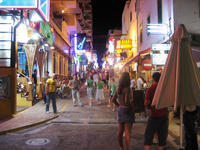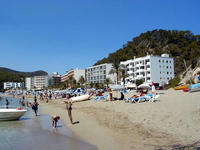You are in: Europe -> Spain -> Ibiza, Biodiversity ... , and traditional search or Image Gallery will yield results of this site only
Ibiza, Biodiversity and Culture
| Site number: | 417 |
|
| Type of site: | Mixed | |
| Date: | - | |
| Date of Inscription: | 1999 | |
| Location: | Europe, Spain, Balearic Islands | |
Up to 75 images are shown here. Click on each for more details or on Image Gallery for more images.
| Description: | Ibiza offers a brilliant illustration of marine and coastal ecosystem interaction. The oceanic Posidonia (seagrass) is an imperative endemic species found only in the Mediterranean basin; dense prairies of it within the site hold and sustain a range of marine life. The long history of Ibiza is preserved within considerable evidence. The Sa Caleta (settlement) and Puig des Molins (necropolis) archaeological sites give evidence to the island’s central role in the Mediterranean economy in protohistory (for the most part in the Phoenician-Carthaginian period). The exceptional Renaissance military architecture of the fortified Upper Town (Alta Vila) had a great influence on the development of fortifications in the New World’s Spanish settlements. --WHMNet paraphrase from the description at WHC Site, where additional information is available. | |
| Ibiza is one of the Balearic Islands located in the Mediterranean Sea, belonging to Spain. With Formentera, it is one of the two Pine Islands. Major cities are Ibiza, Santa Eulària des Riu and Sant Antoni de Portmany. Eivissa is the official Catalan name, but the name in Spanish is Ibiza. In 654 BC Phoenician settlers founded a port in the Balearic Islands, as Ibossim (from the Phoenician ibshim "island of pines"). It was later known to Romans as "Ebusus". The Greeks, who came to Ibiza during the time of the Phoenicians, were the first to call the two islands of Ibiza and Formentera the Pitiusas ("pine-covered islands"; a translation of the Phoenician name). With the decline of Phoenicia after the Assyrian invasions, Ibiza came under the control of Carthage, also a former Phoenician colony. The island produced dye, salt, fish sauce (garum), and wool. A large portions of the island are registered as U.N. World Heritage Sites, and thus devoid of the commercialization of the main cities, for example, "God's Finger" in the Benirràs Bay, or more traditional Ibicenco cultural sites. Because of its purported natural beauty, companies and artists alike frequently use the island for photographic and film shoots. A monument ("The Egg") erected in honour of Christopher Columbus can be found in Sant Antoni: Ibiza is one of several places purporting to be his birthplace. Spectacular sites can be seen from all over the island, including El Vedrà – said to be the third most magnetic point on earth, behind the North Pole and the Bermuda Triangle. --Wikipedia. Text is available under the Creative Commons Attribution-ShareAlike License. | ||
| Source: | http://whc.unesco.org/en/list/417 | |
| Reference: | 1. UNESCO World Heritage Center, Site Page. | |

















